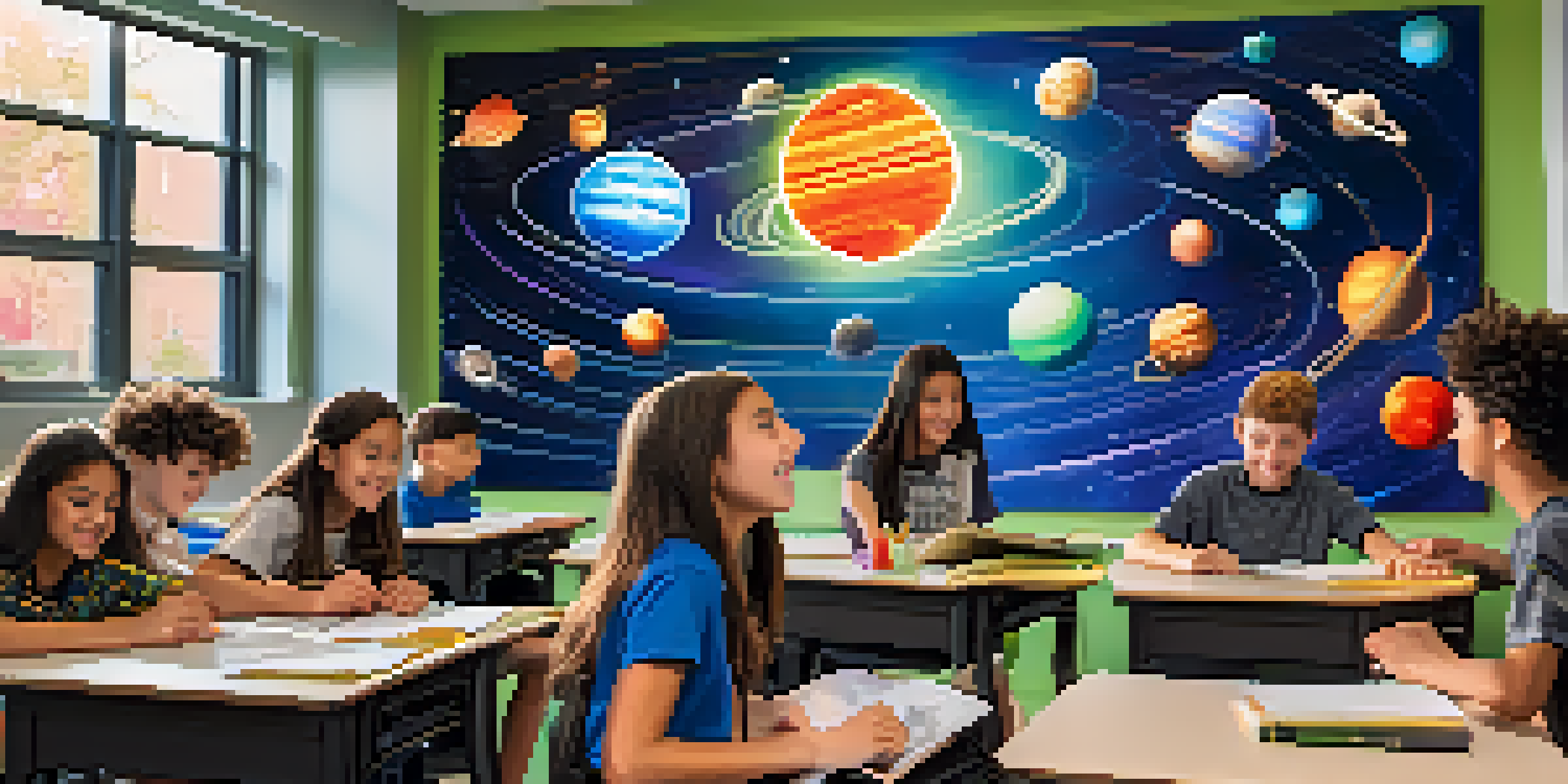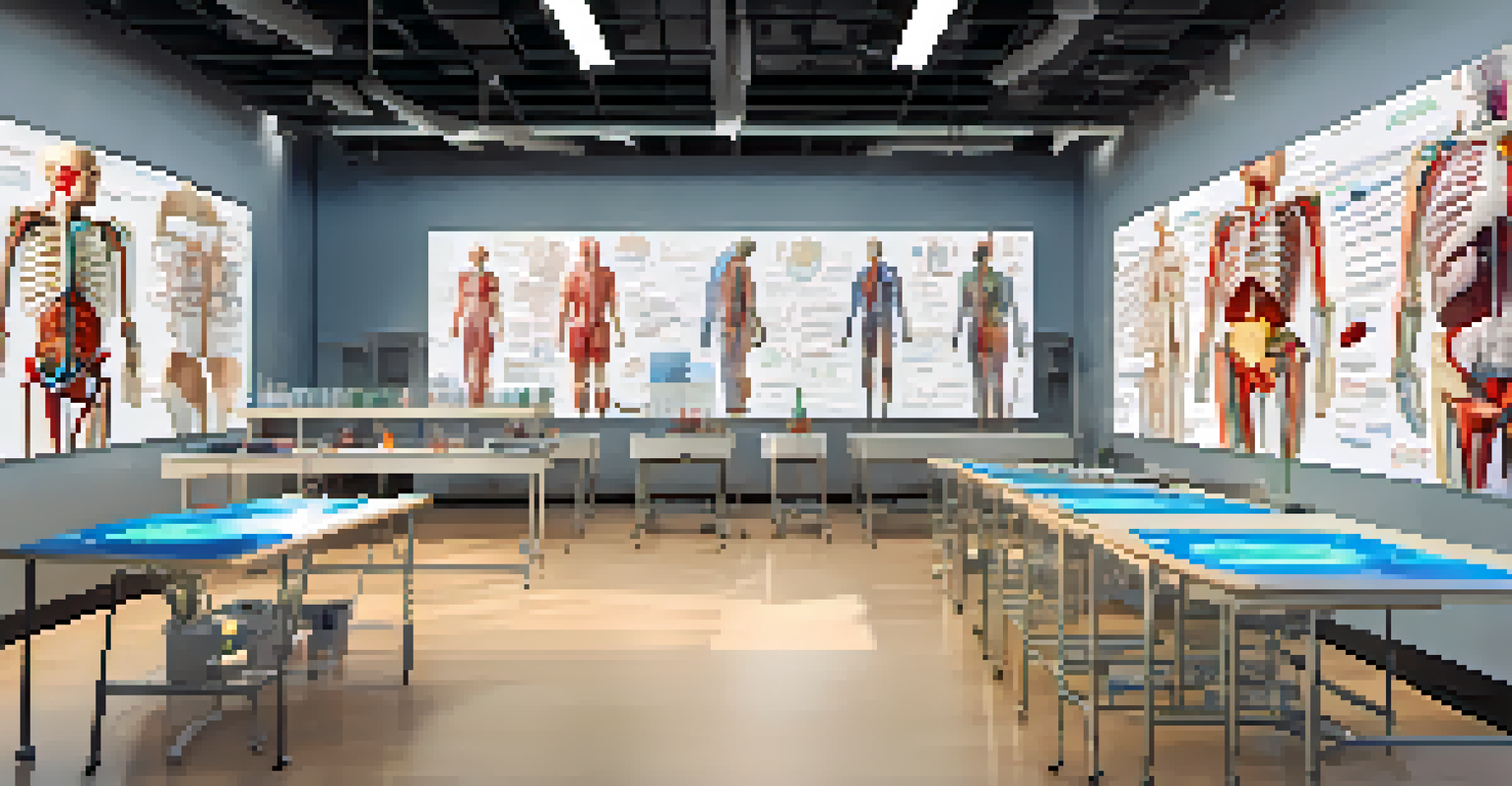The Psychological Effects of AR on Learning Engagement

Understanding Augmented Reality in Education
Augmented Reality (AR) blends digital content with the real world, enhancing the learning experience. Imagine sitting in a classroom and seeing a 3D model of the solar system hovering above your desk. This immersive interaction can spark curiosity and make complex subjects easier to grasp. By engaging multiple senses, AR allows students to connect theoretical concepts with visual representations, bridging gaps in understanding.
The great aim of education is not knowledge but action.
AR technology can transform traditional teaching methods, making lessons more interactive and enjoyable. For instance, instead of merely reading about historical events, students can experience them through AR simulations. This kind of engagement not only keeps students interested but also encourages active participation in the learning process. As a result, students may retain information better when they can visualize and interact with the material.
Moreover, incorporating AR into education can cater to various learning styles, accommodating visual, auditory, and kinesthetic learners. By appealing to different preferences, AR fosters an inclusive learning environment. This adaptability can lead to increased motivation and a deeper connection to the subject matter, as students feel more invested in their learning journeys.
The Impact of Immersive Learning Experiences
Immersive learning experiences created by AR can significantly enhance student engagement. When learners are fully immersed in an interactive environment, they are more likely to focus and retain information. This heightened engagement can lead to improved academic performance and a deeper understanding of complex concepts.

For example, a biology class utilizing AR might allow students to explore a virtual human body, examining organs and systems up close. Such hands-on experiences not only make learning fun but also promote critical thinking and problem-solving skills. Students are more likely to ask questions and seek answers when they can visually explore the subject matter.
AR Enhances Learning Engagement
Augmented Reality transforms traditional teaching methods by making lessons interactive, leading to improved student engagement and information retention.
Additionally, immersive experiences can foster collaboration among students. When working together to solve AR-based challenges, learners develop teamwork skills and build social connections. This collaborative approach can create a supportive learning community, further enhancing engagement and motivation.
Cognitive Load and AR Learning Environments
While AR can enhance engagement, it's essential to consider cognitive load—the amount of information our brains can process at once. An overloaded cognitive system can lead to frustration and disengagement. Therefore, AR applications should be designed thoughtfully to ensure that the information presented is manageable and enhances learning.
Curiosity is the wick in the candle of learning.
For instance, if an AR app bombards students with too much data at once, it may overwhelm them rather than facilitate understanding. Instead, breaking down information into bite-sized, digestible segments can help learners absorb the content without feeling swamped. This balance is crucial for maintaining a positive learning experience.
Moreover, educators should provide guidance on how to use AR tools effectively. Clear instructions and support can help students navigate AR environments without feeling lost. When students feel confident using AR, they are more likely to engage actively with the content, leading to a richer learning experience.
Emotional Engagement Through AR Experiences
AR has the potential to evoke strong emotional responses, which can enhance learning engagement. When students feel emotionally connected to the material, they are more likely to remember it. For example, a history lesson that allows students to walk through a virtual battlefield can create a powerful emotional experience, fostering empathy and understanding.
These emotional connections can also motivate students to dive deeper into subjects that resonate with them. When learners see the relevance of their studies in a relatable context, they are more inclined to explore further and seek additional knowledge. This intrinsic motivation is a key driver of engagement and success in education.
Emotional Connections Boost Learning
AR evokes strong emotional responses that foster empathy and intrinsic motivation, enhancing students' commitment to their studies.
Furthermore, AR can support personalized learning experiences, catering to individual interests and emotional responses. By allowing students to choose topics or scenarios that resonate with them, educators can harness their emotional engagement to enhance the learning process. This tailored approach can lead to more meaningful and impactful educational experiences.
Fostering Curiosity and Exploration with AR
Curiosity is a vital element of effective learning, and AR can play a significant role in sparking it. When students engage with AR technology, they are often intrigued by the possibilities of exploration and discovery. For instance, an AR app that lets students explore ancient ruins can ignite interest in archaeology and history.
This sense of exploration encourages students to ask questions and seek answers beyond the classroom. By promoting curiosity, AR can empower learners to take ownership of their education, motivating them to delve deeper into subjects. As a result, students become active participants in their learning journeys rather than passive recipients of information.
Moreover, AR can facilitate a sense of wonder about the world. When learners see digital overlays of information in real-time, they may develop a broader perspective on various topics. This newfound curiosity can lead to a lifelong love of learning, which is essential for personal and professional growth.
Challenges and Limitations of AR in Learning
Despite its benefits, the integration of AR in education does come with challenges. One significant hurdle is the accessibility of technology, as not all students have access to AR devices or high-speed internet. This disparity can create inequalities in learning opportunities, limiting the effectiveness of AR as a teaching tool.
Additionally, educators may face a learning curve when incorporating AR into their teaching practices. They must be trained to use AR technology effectively and integrate it into their lesson plans. Without proper support and resources, the potential of AR to enhance learning engagement may not be fully realized.
Curiosity Drives Exploration with AR
By sparking curiosity, AR empowers students to take ownership of their learning, encouraging deeper exploration beyond the classroom.
Furthermore, there can be resistance from both students and educators who may be hesitant to adopt new technologies. Overcoming this skepticism requires demonstrating the clear benefits of AR in learning. As more success stories emerge, it can help build confidence in AR as a valuable educational tool.
The Future of AR in Educational Engagement
As technology continues to evolve, the future of AR in education looks promising. Innovations in AR software and hardware will likely make these tools more accessible and user-friendly for both educators and students. This evolution could lead to broader adoption of AR technology in classrooms worldwide, enhancing learning experiences.
Moreover, as research continues to explore the psychological effects of AR on engagement, we can expect more evidence-based practices to emerge. Educators will be better equipped to design AR experiences that effectively cater to diverse learning needs and preferences. This tailored approach can ensure that AR truly enhances educational outcomes.

Ultimately, the integration of AR in education has the potential to revolutionize how we teach and learn. By harnessing the power of immersive, interactive experiences, we can create engaging environments that inspire curiosity, foster collaboration, and promote a lifelong love of learning.